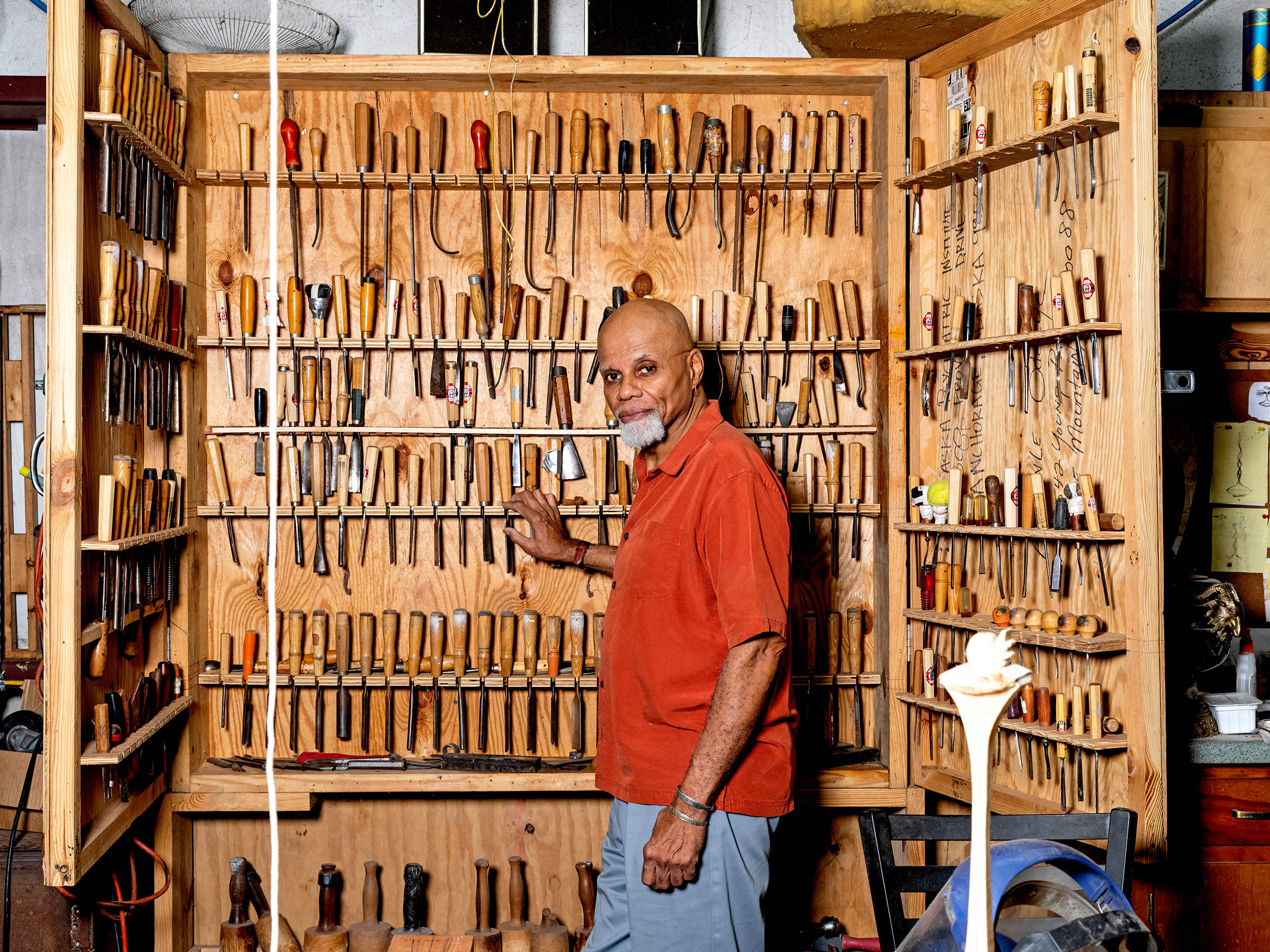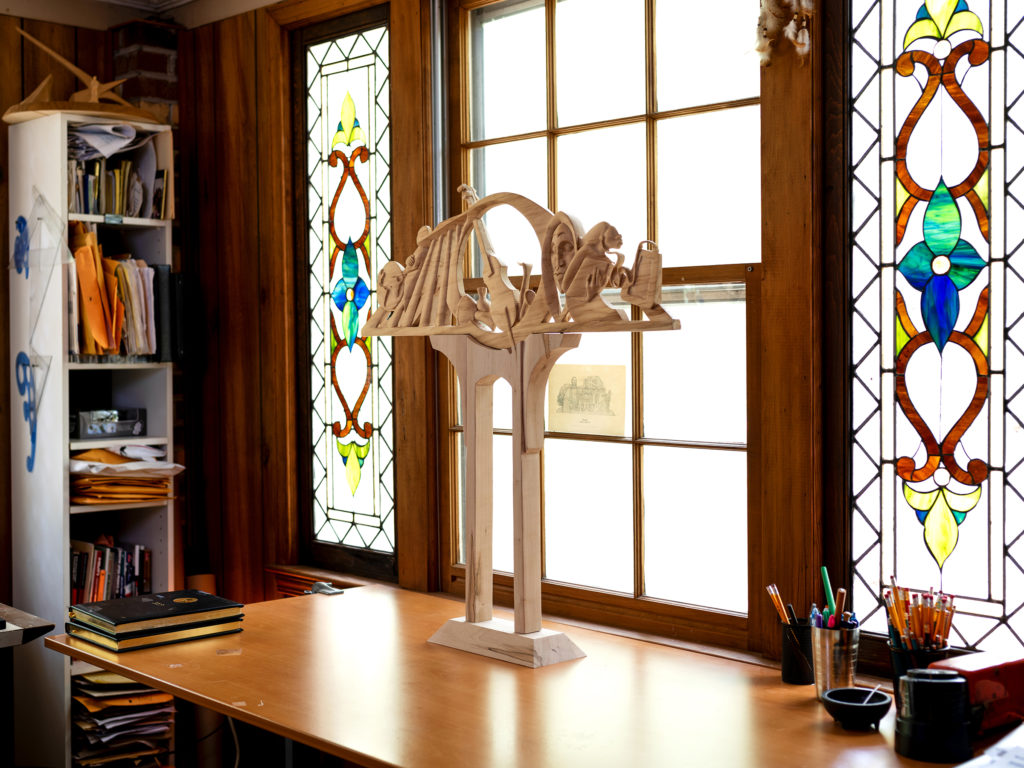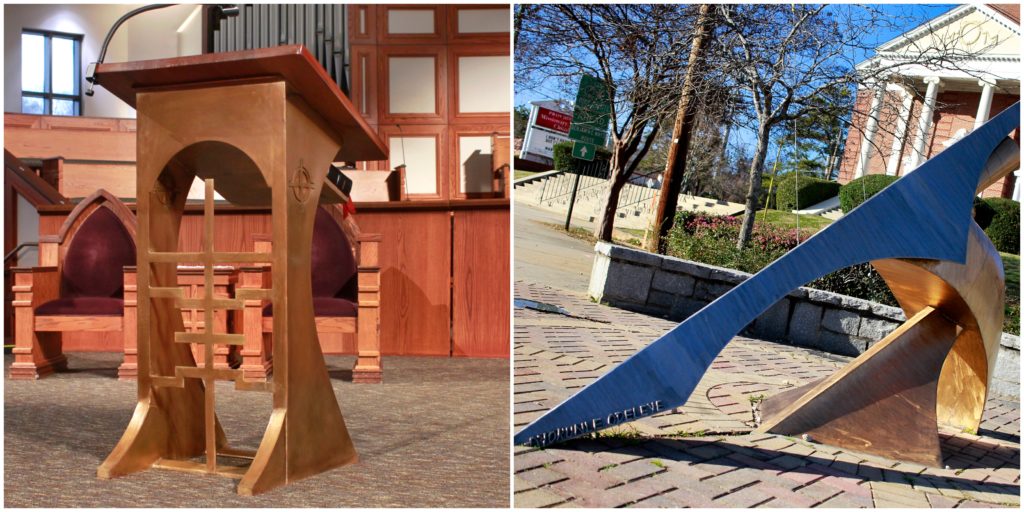With Sculptures All Over Atlanta, Artist Aims To Reflect ‘Diversity Of Communities’

Ayokunle Odeleye poses in his wood working studio.
In his home workshop in Stone Mountain, Georgia, Ayokunle Odeleye’s larger-than-life pieces of public art often start as a small wooden mock-up, that he shapes with a lathe.
The finished product can wind up soaring into the air.
Like the bronze monument called Spirit, Family, Community in Peoplestown that went up before the 1996 Olympics.
Or his latest commission, a 30-foot tall by 27-foot wide steel “Gateway” monument that’s planned for southwest Atlanta. It’s a sculpture that will feature the likeness of Dr. Martin Luther King Jr., imagery paying tribute to the African-American heritage of many of the city’s residents and an homage to Atlanta’s educational and religious institutions and music scene.
And at a time when monuments and statues glorifying the confederacy and white supremacy are coming down across Georgia, will more projects like these rise up in their place?
Odeleye has been creating public artwork that commemorates a more complete history – of our communities and our country for four decades.
But he says this type of public art work isn’t likely to just spring up overnight. Odeleye says, with a few exceptions such as Atlanta, artists of color often face barriers to winning commissions for projects when the majority of public art directors and the selection committees they choose are mainly white.
“In most instances, that’s the case, all the way down the chain,” he said. “So there’s a struggle for African-American and other brown artists to be recognized, even when their credentials show that they can do the work.”
He says for public art to be more inclusive, change has to start at the top.
‘It Doesn’t Get Any Better Than That’
There are no windows in Odeleye’s workshop, and sometimes he can lose track of time, opening the door to find darkness has fallen.
He usually has music going – anything upbeat, he says.
“You know with Coltrane blasting, and I’m in here working, it doesn’t get any better than that. I feel sorry for anyone who’s not an artist at that point,” said Odeleye. “It doesn’t get any better.”

Odeleye is tall and lean with a gray goatee. He’s 68 years old and has more time for his projects now that he’s retired after nearly 30 years in the classroom at Kennesaw State.
Teaching is what brought him to Atlanta in the early 1980s. He chose that profession because he wanted to do for his students what his high school and college instructors did for him.
“To give them ideas to work with them to watch them grow to watch them learn is an exciting thing,” said Odeleye. “It’s kind of like throwing seeds in the dirt. Over time you watch those seeds take root. And beautiful kinds of things occur.”
‘The Evolution, The Growth, The Diversity of Communities’
In addition to teaching, Odeleye has spent his career specializing in public artwork, creating dozens of projects around the country. Capturing the history of a place in a piece of public art is Odeleye’s specialty.
“I’ve done slave memorials, I’ve done pieces that honor particular individuals. I’ve done pieces where the city has wanted to talk about the history of the city, both the struggles, the evolution, the growth, the diversity of communities,” he said.
One of those cities is Wilmington, North Carolina, where he created a monument made up six bronze boat paddles each reaching 16 feet into the air.
That monument commemorates a race riot in 1898, in which a white mob overthrew the city government and terrorized the African-American community.
In addition to his works around the country, his art can be found in Atlanta as well.
For example, Odeleye crafted the lectern at Ebenezer Baptist Church.
And on Cascade Road, there’s working steel sundial he created, surrounded by twelve-hour markers, each adorned with the name of someone from that neighborhood who’s made an impact on the world.

Most of those names incorporated into the sundial project were submitted by members of the community.
“They wanted a work that really highlighted education, learning – that’s a middle-class community – education is very important to them,” said Odeleye. “And so, when I listened to the committee talk about those things, I came up with the concept of enlightenment.”
It’s this kind of community involvement, Odeleye says, that’s an integral part of his artistic process.
And it’s what makes public art meaningful to the people who see it most.








